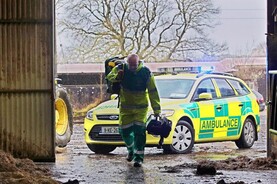The Health and Safety Authority's report for 2023 indicated of the 16 farming fatalities, five involved livestock.
The HSA has outlined the risks when working with livestock, and has key advice on how to safely manage stock.
10 tips for safely working with livestock
1. Work out an escape route or refuge area in advance of working with cattle, and know and understand the basics of cattle behaviour.
2. Make sure persons handling cattle are competent and agile and between the ages of 18-65.
3. Ideally maximise the use of artificial insemination, and if bulls are used, try to ensure that they produce docile offspring. Bulls cause over 50% of livestock related deaths on Irish farms. Never turn your back on a bull.
4. Be careful around cows that are calving or with new-born calves as they are more likely to attack.
5. Remember that cows that are 'on-heat' are unpredictable.
6. Good stockmanship skills are essential. This will ensure the cattle are not stressed and will reduce the risk of injury to the handler. Try to keep cattle calm when handling them - use a stick or paddle to assist in directing cattle, avoid excessive yelling.
7. Debud calves early to prevent horn growth and watch for warning signs of animal aggressiveness, and cull irritable and difficult cattle.
8. Exercise caution when administering veterinary treatments and wear suitable protective clothing and footwear.
9. Use well-designed facilities and regularly check and maintain facilities such as the crush, gate latches and fences. Keep ground surfaces clean and clear of trip hazards, as far as possible.
10. Provide suitable training and adequate supervision to young and inexperienced persons working with cattle. Very young children are at risk if around cattle and should never be allowed to enter yards or fields with livestock unless with an adult.
Think ahead
The HSA advises farmers to think ahead when working with livestock.
Keep your mobile phone in your pocket so you can call for help, if needed and tell someone else where you are and when you expect to return.
A first aid box should be kept in your vehicle or shed, with supplies of plasters, bandages and disinfectant to treat minor cuts and grazes. Ensure you have public liability insurance in place and that it covers transport of cattle on the road.






 This is a subscriber-only article
This is a subscriber-only article










SHARING OPTIONS: